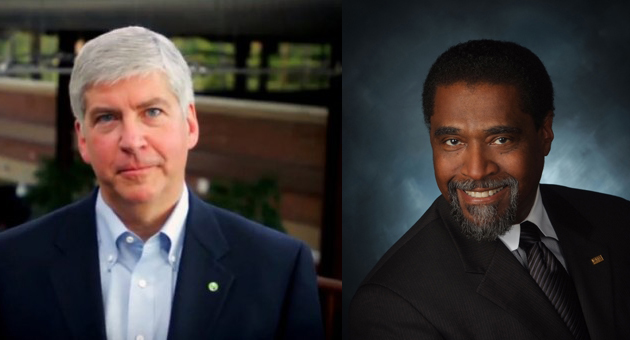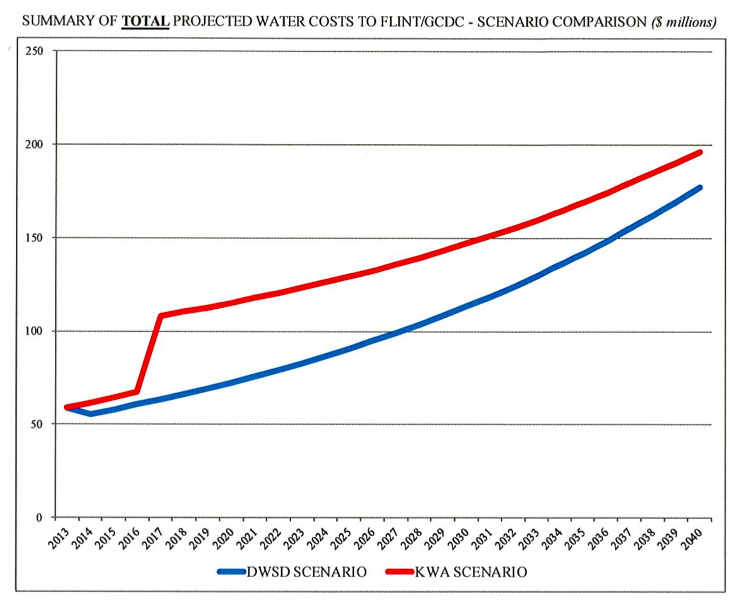
By Steve Neavling
Motor City Mucrkraker
When Flint began drawing its water from the Flint River in April 2014, a decision that led to the poisoning of tens of thousands of people, state officials washed their hands of blame.
But e-mails and documents obtained this week by Motor City Muckraker show that Gov. Snyder and Flint’s emergency managers repeatedly lied about their role in the process and even knew of the dangers of using the Flint River and the financial and operational risks of building a new pipeline.
On March 7, 2014, Flint Emergency Manager Darnell Earley wrote in an e-mail to the Detroit Water and Sewerage Department (DWSD) that he was not interested in a short-term contract to avoid using the Flint River, despite serious concerns raised by the Michigan Department of Environmental Quality in 2012.
“There will be no need for Flint to continue purchasing water (from DWSD) to serve its residents and businesses after April 17, 2014,” Earley wrote to DWSD Director Sue McCormick.
But months later, after studies began to show dangerously elevated levels of lead from Flint River water, Earley and Snyder both claimed the emergency manager was forced to use the river because DWSD insisted it would cut off the city without a long-term contract.
“The Detroit Water and Sewer Department at the time, back last spring, said, ‘Hey, we’re gonna cut you off,’” Snyder spokeswoman Sara Wurfell told the ACLU.
Snyder made the same claim during his State of the State earlier this month.
Those claims are untrue. Records show that DWSD urgently tried to get Flint to sign a short-term contract to avoid the health dangers of the Flint River.
But state officials, including Earley, who is now the emergency manager of Detroit Public Schools, insisted on using the Flint River and signed off on the decision.
Documents also call into question whether the switch to a new pipeline was about saving money.
DWSD offered a deal that would have saved Flint $800 million, which was 20% more inexpensive than switching to the Karegnondi Water Authority.
What’s more, an engineering firm hired by the state’s Department of Treasury released a study in February 2013 that expressed concerns about the financial and operational risks of building the KWA pipeline, which had already cost 24% more than originally projected, and that’s not including anticipated cost overruns in the future.
Many of the concerns involved the risks of building a new system and officials’ failure to acknowledge that the KWA pipeline would be more expensive than they were telling the public.
“There is a concern over the ability of smaller systems (KWA) over larger systems (DWSD) to pay for future unfunded mandates and regulations,” the report states. “Obviously, identifying regulation requirements over 30 years is hard to determine. However, it is widely accepted that a large system has greater ability to respond to unfunded mandates because the cost can be distributed over a large customer base.”
The reported added: “DWSD has backup power at all of its major facilities supplying Flint. The KWA system will not have a redundant power at its pumping facilities. This would be a major risk.”
Bill Johnson, who was hired in May 2013 to discourage Flint from building a new pipeline or using the Flint River, said he was baffled by the state’s response.
“There was nothing we could do to make them sign a contact,” Johnson told Motor City Muckraker on Monday. “They already had made up their minds. They wouldn’t even entertain an offer.”
Johnson told Motor City Muckraker that Snyder was to blame.
“This was all the governor’s decision,” Johnson said. “It was a political decision that had nothing to do with saving money for Flint.”
Curt Guyette, an investigative reporter who works for the ACLU of Michigan, also revealed through deposition records that the DEQ warned of the dangers of using the Flint River, prompting then-Emergency Manager Ed Kurtz to reject the river as a source of drinking water in December 2012.
What’s unclear is why state officials still went ahead with the plan.
“The insistence of Flint officials to pursue construction of the KWA pipeline can only be attributed to a ‘political’ objective that has nothing to do with the delivery – or the price – of water,” DWSD said in a press release on April 1, 2013. “Flint’s fiscal integrity is stake. And the State of Michigan has an obligation to prevent the distressed city from dragging DWSD and the region into a deeper financial quagmire.”
That same month, McCormick wrote in an email that said she was disappointed with Flint’s refusal to entertain an offer for a short-term solution until the pipeline was built.
“We are disappointed,” she wrote. “Over the past two years, my staff worked tirelessly to have Flint remain a valued customer. We presented what we believed to be worthwhile operational and cost-saving options that would have been mutually beneficial to all parties.”
When the city began using the Flint River in April 2014, officials acknowledged in a press release, “Even with a proven track record of providing perfectly good water for Flint, there still remains lingering uncertainty about the quality of the water.”
Snyder has refused to release e-mails from 2012 and 2013 that may shed light on why state officials moved forward with the plan to use the Flint River despite numerous concerns.
Snyder’s office won’t return our calls.
Steve Neavling
Steve Neavling lives and works in Detroit as an investigative journalist. His stories have uncovered corruption, led to arrests and reforms and prompted FBI investigations.


43 Responses to "New records: Gov. Snyder ignored numerous warnings about Flint water and new pipeline"